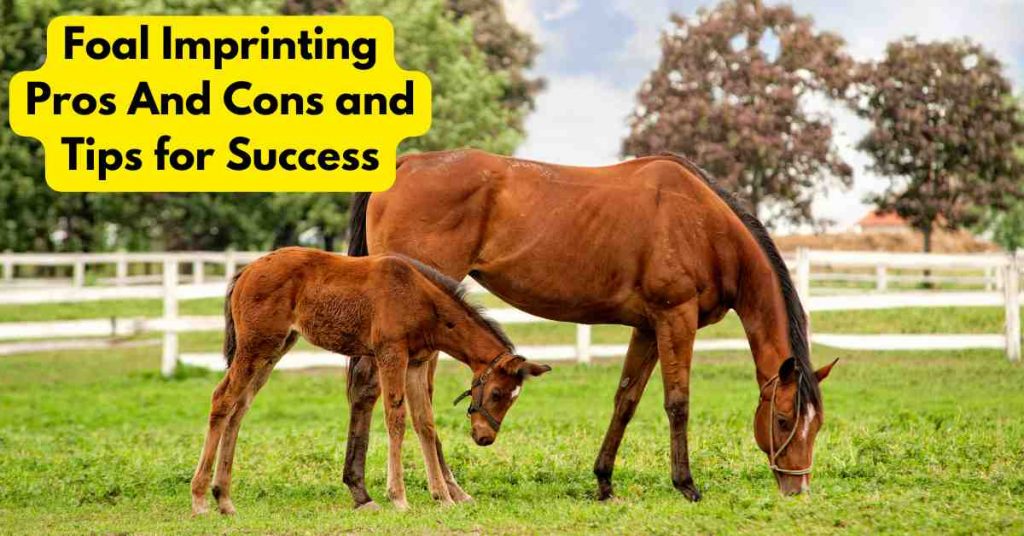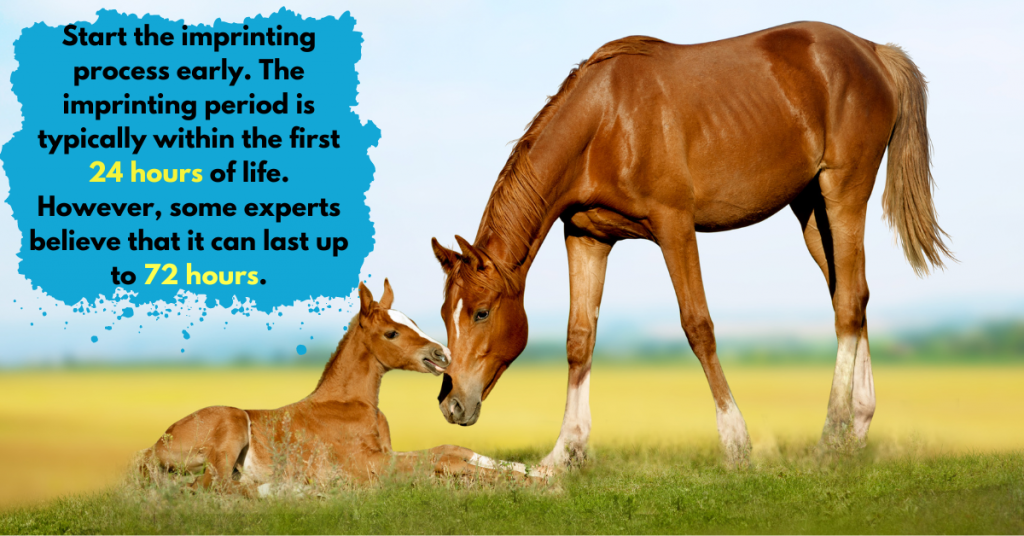Foal Imprinting Pros And Cons and Tips for Success

Foal imprinting is a controversial practice in the equine world that involves handling and training newborn foals shortly after birth. It aims to create a strong bond between the foal and humans and instil positive associations with handling and human contact from an early age. This article delves into the pros and cons of foal imprinting, examining its impact on horse behaviour, development, and welfare.

Let's dive into the topic of Foal Imprinting Pros And Cons.
- Understanding Foal Imprinting
- The Process of Foal Imprinting
- The Pros of Foal Imprinting
- The Cons of Foal Imprinting
- Scientific Studies on Foal Imprinting
- Responsible Foal Handling and Training
- Ethical Considerations and Animal Welfare
- Practical Application of Foal Imprinting
- The Future of Foal Imprinting
- Bottom Line
- FAQs (Frequently Asked Questions)
- What is foal imprinting?
- What is the critical period for foal imprinting?
- Are there any potential drawbacks to foal imprinting?
- Is foal imprinting scientifically supported?
- Can alternative training approaches be considered for foals?
- What is the imprinting period for foals?
- What are the benefits of foal imprinting?
- What are the risks of foal imprinting?
- How do you do foal imprinting?
- Who should do foal imprinting?
- Is foal imprinting suitable for all horses?
- What are the signs of successful foal imprinting?
- How can I avoid the risks of overbonding?
- Are there alternatives to foal imprinting?
- What is the ideal age for foal imprinting?
- Can foal imprinting be reversed?
- What should breeders consider when incorporating imprinting into their programs?
- How does foal imprinting impact horse-human relationships?
- What are the latest developments in foal imprinting research?
- Are there cultural variations in the practice of foal imprinting?
Understanding Foal Imprinting
Foal imprinting is a training technique that gained popularity in the equine world during the latter half of the 20th century. It involves handling and exposing a newborn foal to various stimuli, including touch, sounds, and visual cues, in a controlled and gentle manner. The goal is to create a lasting impression on the foal's mind, promoting positive associations with humans and reducing fear of human contact.
The Process of Foal Imprinting
The window for effective foal imprinting is relatively short, typically within the first few hours of birth. During this critical period, the foal's brain is highly impressionable, making it receptive to learning and forming lasting memories. Various techniques are employed by trainers and breeders to introduce the foal to new experiences, each emphasizing positive reinforcement.
The Pros of Foal Imprinting
Proponents of foal imprinting believe that early and positive human-horse interactions can lead to a strong bond between the horse and its handlers. Additionally, it is thought to accelerate the learning process and promote early socialization, setting the foundation for a well-adjusted and trainable horse.
- Some believe that foal imprinting can help create a more trusting and cooperative horse.
- It can help desensitize the foal to touching, handling, and leading stimuli.
- It can help to teach the foal basic manners, such as standing still for grooming and loading into a trailer.
- It can help to establish the human as the leader of the herd.
The Cons of Foal Imprinting
Critics argue that foal imprinting can be overwhelming and stressful for the young foal, potentially leading to behavioural issues later in life. It may also interfere with the foal's instincts and social dynamics, disrupting the development of essential equine behaviours.
- No scientific evidence supports the claim that foal imprinting makes a lasting difference in the horse's behaviour.
- The process can be stressful for the foal and the mare.
- It can disrupt the natural bonding process between the foal and its mother.
- It can be dangerous if not done properly.
Here are some additional things to consider when deciding whether or not to imprint a foal:
- Your goals for the horse. If you are planning to show or compete the horse, imprinting may be helpful. However, if you are looking for a companion horse, imprinting may not be necessary.
- Your experience level. If you are new to horses, it is best to avoid imprinting. This is a complex process that requires a lot of skill and knowledge.
- The temperament of the mare and foal. Some mares and foals are more amenable to imprinting than others. If the mare is stressed or aggressive, it is best to avoid imprinting.
Ultimately, the decision of whether or not to imprint a foal is up to you. Do your research, weigh the pros and cons, and make the best decision for you and your horse.
Scientific Studies on Foal Imprinting
The scientific community remains divided on the benefits and drawbacks of foal imprinting. Some studies support the positive impact on human-horse relationships, while others raise concerns about its long-term effects on horse behaviour and welfare.
Responsible Foal Handling and Training
As with any training method, responsible implementation is crucial. Horse owners and trainers should consider alternative approaches and prioritize the horse's well-being while still promoting a positive human-horse relationship.
Ethical Considerations and Animal Welfare
Balancing human needs and desires with the horse's welfare is critical for responsible foal imprinting. Ensuring the foal's physical and emotional needs are met should be the foundation of any training program.
Practical Application of Foal Imprinting
Foal imprinting requires expertise and careful observation of individual foals' responses. Seeking professional guidance and understanding each foal's unique personality is essential for successful implementation.
The Future of Foal Imprinting
As equine training evolves, foal imprinting techniques may adapt to incorporate more scientifically supported methods that prioritize the horse's natural behavior and well-being.
Bottom Line
Foal imprinting is a contentious topic in the equine world, with proponents and critics offering their perspectives. While it can create early positive interactions between humans and foals, responsible horse owners must carefully evaluate the potential benefits and drawbacks and prioritize the horse's welfare above all else. As the equine training landscape continues to evolve, a comprehensive and ethical approach to foal handling and training remains crucial for the well-being of our equine companions.
FAQs (Frequently Asked Questions)
Here is a list of FAQs about Foal Imprinting Pros And Cons.
What is foal imprinting?
Foal imprinting is a training technique that involves handling and exposing a newborn foal to various stimuli shortly after birth, aiming to create positive associations with humans.
What is the critical period for foal imprinting?
The critical period for imprinting is within the first few hours of birth when the foal's brain is highly impressionable.
Are there any potential drawbacks to foal imprinting?
Critics argue that foal imprinting can be stressful for the foal and may interfere with its natural behaviours.
Is foal imprinting scientifically supported?
Scientific studies on foal imprinting offer conflicting results, with some supporting its benefits and others expressing concerns.
Can alternative training approaches be considered for foals?
Responsible horse owners may consider alternative training methods that prioritize the horse's natural behaviours.
What is the imprinting period for foals?
The imprinting period for foals is typically within the first 24 hours of life. However, some experts believe that it can last up to 72 hours.
What are the benefits of foal imprinting?
Foal imprinting can help create a more trusting and cooperative horse. It can also help desensitize the foal to touching, handling, and leading stimuli. It can also help teach the foal basic manners, such as standing still for grooming and loading into a trailer.
What are the risks of foal imprinting?
The main risk of imprinting is that it can be stressful for the foal and the mare. It can also disrupt the natural bond between the foal and its mother. Additionally, if the imprinting is not done properly, it can lead to behavioural problems in the horse later in life.
How do you do foal imprinting?
The process of foal imprinting involves gently handling and exposing the foal to various stimuli. This can include touching the foal all over its body, leading it around, and exposing it to different sounds and smells. It is important to be patient and gentle during the imprinting process and to avoid causing the foal any stress.
Who should do foal imprinting?
Foal imprinting is a complex process that experienced professionals should only do. If you are not shared with horses, it is best to avoid imprinting a foal.
Is foal imprinting suitable for all horses?
Foal imprinting can benefit many horses, but individual temperament and breed characteristics should be considered. Consult with a knowledgeable trainer or veterinarian for personalized advice.
What are the signs of successful foal imprinting?
Signs of successful imprinting include a strong bond between the foal and humans, reduced stress, and improved handling and behaviour.
How can I avoid the risks of overbonding?
To avoid overbonding, maintain a balanced training approach and closely monitor the foal's behaviour and reactions. Seek professional guidance if needed.
Are there alternatives to foal imprinting?
Yes, there are alternative training methods. Foal imprinting should be viewed as one tool in a trainer's toolbox, and its suitability depends on the individual horse and its goals.
What is the ideal age for foal imprinting?
Foal imprinting is typically done shortly after birth when foals are most receptive to human interaction.
Can foal imprinting be reversed?
It can be challenging to reverse the effects of foal imprinting, so it's essential to approach the practice with care and consideration.
What should breeders consider when incorporating imprinting into their programs?
Breeders should assess their breeding goals, horse temperament, and staff expertise before integrating foal imprinting into their programs.
How does foal imprinting impact horse-human relationships?
Foal imprinting can lead to stronger and more positive horse-human relationships, fostering trust and cooperation.
What are the latest developments in foal imprinting research?
Stay updated on the latest research through equine science journals and reputable sources to learn about new findings and techniques.
Are there cultural variations in the practice of foal imprinting?
Cultural variations in foal imprinting practices exist, with some cultures emphasising traditional training methods. It's essential to consider these differences in a global context.
